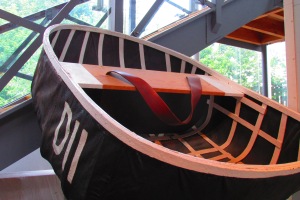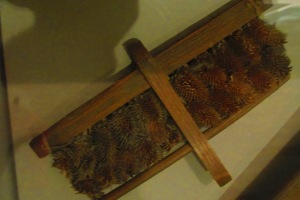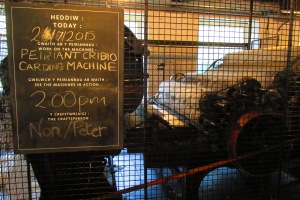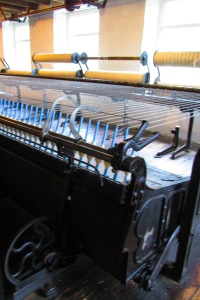Sunny days are for exploring gardens; rainy days for museums.While visiting friends in west Wales this summer, one such soggy Sunday endeared to us the idea of a trip to a historical establishment. So off we went to Dre-Fach Felindre to nosey around the National Wool Museum. Giving an insight into the traditional and industrial processes of converting fleece into yarn and cloth, this museum also documents the history of the wool trade in Wales.
It all starts, of course, with sheep. Different breeds have adapted to cope with their contrasting environs, and the texture of their fleece reflects this. For example, the hardy Welsh Mountain sheep gives us a coarse wool, whereas the Llanwenog (a lowland breed typical of the Teifi valley) has a soft, fine wool. Prior to shearing, sheep were washed in streams, rivers or the sea, as this was thought to make hand-shearing easier. Men would take to coracles to guide any stray sheep or those getting into trouble in the water. I love the unusual image of sheep-herding in coracles!
Though shearing was the most typical way of removing wool from a sheep’s back, there were other ways. ‘Slipe wool’ was obtained from dead sheep purchased from slaughterhouses which gave cheap, low-grade wool. Fleece was detached from the carcasses by throwing them into lime pits, and the skin and lime later separated from the wool in a large revolving drum.
A less gruesome method was the old Welsh custom of gwlana. This involved women traipsing along the drover’s roads known as llwybrau gwlan, or woollen paths, retrieving oddments of wool caught up in hedgerows. This was no pleasant stroll in the country – these women would have been up at daybreak and, come sun down, would have trundled many miles in every weather, hefting home heavy sacks of wool gathered by stooping and bending much of the day. Even so, gwlana was a social experience and something different from the drudgery of everyday life. The wool that was collected was cleaned and spun by hand, to be knitted into socks or caps, or woven into blankets that could be sold to earn extra pennies on top of meagre farm wages. With the arrival of the railway in the late 1800s, the need for drovers declined, and woollen paths fell out of use. But the role of drovers had extended beyond livestock: they were the original bankers of Wales.. The first Welsh bank notes were issued by Banc y Ddafad Du (the Black Sheep Bank) of Aberystwyth, and Banc yr Ychain Du (the black Ox Bank) of Llandovery.
Once in the mill, wool had to be sorted and then prepared for spinning. Fleece cannot be spun straight away as it is too ravelled, and undergoes a treatment called ‘willowing’. Prior to mechanisation, this was done on a felking board, using sticks probably cut from willow. Come the industrial ages, a willowing machine combed the wool, teasing out tangles on a metal toothed roller. This transformed the wool into a sort of candy-floss cloud of fibre. Another combing task. ‘carding’, turned the soft fluffy fibres into strips of wool known as ‘rovings’ or ‘rolags’. By hand, this was done with carding bats which had metal or wire teeth. The earliest carding bats had teasel or thistle heads. Being a gardener for a living, I found this especially interesting. The scientific name for thistle is Cardus, from which the word carding is derived. The Welsh for teasel is llysiau’r cribwr and translates as ‘the carder’s plant’.
During my visit, there was a demonstration of the willowing and carding machine in use, and I found it a bit odd that the machine operatives were called craftspeople. This jarred with my sense of the word craft, as I tend to think of it in relation to non-mechanised activities. Is that just me, or does anyone else have this perception too?
The rolags produced by carding were then spun, converting the fluffy wool into strong yarn. Traditionally done by individuals at spinning wheels, the invention of a machine called the ‘spinning mule’ put a lot of local spinners out of work. This machine wheeled backward and forwards, drawing out and twisting the fibre together, producing 400 threads at once. It required only a single operator, saving the mill owner money in wages and allowing the maximisation of profit.
Once wound onto bobbins, this yarn was ready for knitting or weaving. One way of incorporating some knitting into the day was whilst walking: in the 19th century, women in Cardiganshire were known to knit their way down mountains, carrying peat harvested from the higher land to use as fuel in coastal areas. I’ve seen people knit on public transport, but I’d be worried about tripping up and rolling downhill like a giant ball of wool! A vital rural industry in the 18th and early 19th centuries was the home knitting of socks and stockings. Wares were sold door to door or at markets, as well as to itinerant stocking merchants. People who knitted for money frequently convened for their shared purpose, merging work with play… and a bit of friendly (I hope!) rivalry. Sometimes, competitions called Gwau Gwryd were held, testing who could most speedily knit a given measure of wool. Of course, mechanisation also put knitters out of work as stockings made in factories were cheaper, and these finer stockings became more fashionable. I think that’s why crochet appeals to me: it has yet to be mechanised.
Despite putting many people out of work through industrialisation, the woollen mills were the biggest employers in the Teifi valley until the 1980s. The wool museum, on the site of the old Cambrian mill, still produces wool and cloth today. And visiting was a wet afternoon well spent.



 Teasel (above); a carding bat with teasel heads (below)
Teasel (above); a carding bat with teasel heads (below)


What an interesting post 😊
Thanks! It’s an interesting place – worth a visit in your fab campervan Ruby!
Hello again, I have just nominated you for the Liebster Blog Award! It would be great if you could join in but I completely understand if you’d rather not – please don’t feel obliged! I was in two minds myself when I was nominated. You can find out all about it in my post here http://coastalcrochet.com/2015/09/25/liebster-award/
Very Best Wishes, Eleonora 🙂
Hi Eleonora, and thanks for this! I’ll have a think about it, but won’t do anything about it for a while as I’m away on holiday tomorrow and will be leaving computer/blog behind. I’ll be taking my crochet with me though, so may have things to report on my return 🙂
Maria
Hope you have a wonderful holiday 😊